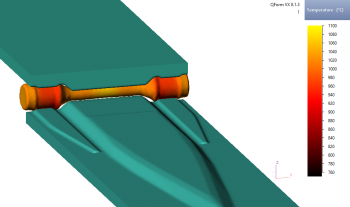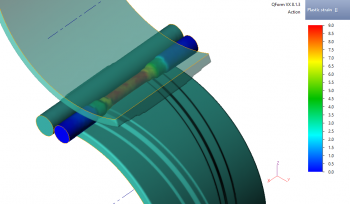Cross-wedge rolling
 Cross-wedge rolling by flat dies simulation in QForm
Cross-wedge rolling by flat dies simulation in QForm
Cross-wedge rolling is an economical and effective way to produce preforms with variations in cross section diameters. The process rolls the workpiece between rotating dies to create various diameters across the length of the workpiece.
Designing tools for cross-wedge rolling is a very difficult and intensive process, and production of these tools is expensive. QForm software significantly reduces the time and cost for designing and realization of this technological process. QForm allows simulation of the entire process chain including cross-wedge rolling as preforming operation and subsequent forging operations. Simulation of this preform process is the only way to insure the best accuracy in subsequent forging operations.
Advantages
- Reduced technology development cost by testing on your computer without no need to produce test equipment or perform trials on a rolling machine
- Optimization of the entire forging technology chain including cross-wedge rolling process optimization by means of simulation in QForm
- Prediction of forged part properties after cross-wedge rolling operation, i.e. by analyzing temperature, effective strain field and macrostructure of forged part
- Determination of optimal workpiece shape
- Virtual designing of the entire technological chain on your computer
- Using a virtual prototype for discussion with the customer offers a better understanding of the real process. Production staff can see inside the process that allows for better cooperation between engineers and technologists
 Cross-wedge rolling by rolls simulation in QForm
Cross-wedge rolling by rolls simulation in QForm
Special QForm features that help simulate cross-wedge rolling
- Special algorithms are applied to achieve high accuracy of formation prediction in processes where the workpiece is rotating during the process
- Automatic inheriting of cross-wedge rolling simulation results to subsequent forging operations
- Tracking user defined lines and points through the entire process for macrostructure prediction and for analysis of evolution of any field at specific points.
- Any point or line can be traced from the beginning of cross-wedge rolling operation to the end of the entire technological chain of all forging operations
- All technological chains of operations are in one simulation file
Example
There are two typical methods of cross wedge rolling: One that uses flat linear dies, and the other that uses round rotating dies.
The video below shows these two methods. The first part of the following video shows the process of cross-wedge rolling using flat tools and the second part shows the process of cross-wedge rolling using round tools.




